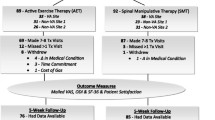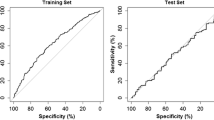Abstract
A clinical prediction rule to identify patients most likely to respond to spinal manipulation has been published and widely cited but requires further testing for external validity. We performed a pre-planned secondary analysis of a randomised controlled trial investigating the efficacy of spinal manipulative therapy in 239 patients presenting to general practice clinics for acute, non-specific, low back pain. Patients were randomised to receive spinal manipulative therapy or placebo 2 to 3 times per week for up to 4 weeks. All patients received general practitioner care (advice and paracetamol). Outcomes were pain and disability measured at 1, 2, 4 and 12 weeks. Status on the clinical prediction rule was measured at baseline. The clinical prediction rule performed no better than chance in identifying patients with acute, non-specific low back pain most likely to respond to spinal manipulative therapy (pain P = 0.805, disability P = 0.600). At 1-week follow-up, the mean difference in effect of spinal manipulative therapy compared to placebo in patients who were rule positive rather than rule negative was 0.3 points less on a 10-point pain scale (95% CI −0.8 to 1.4). The clinical prediction rule proposed by Childs et al. did not generalise to patients presenting to primary care with acute low back pain who received a course of spinal manipulative therapy.


Similar content being viewed by others
References
Assendelft WJJ, Morton SC, Yu EI, Suttorp MJ, Shekelle PG (2004) Spinal manipulative therapy for low back pain. Cochrane Database Syst Rev CD000447
Beattie P, Nelson R (2006) Clinical prediction rules: what are they and what do they tell us? Aust J Physiother 52:157–163
Bekkering GE, Hendriks HJM, van Tulder MW, Knol DL, Simmonds MJ, Oostendorp RAB et al (2005) Prognostic factors for low back pain in patients referred for physiotherapy: comparing outcomes and varying modeling techniques. Spine 30:1881–1886
Brookes ST, Whitely E, Egger M, Smith GD, Mulheran PA, Peters TJ (2004) Subgroup analyses in randomized trials: risks of subgroup-specific analyses; power and sample size for the interaction test. J Clin Epidemiol 57:229–236
Brookes ST, Whitley E, Peters TJ, Mulheran PA, Egger M, Davey Smith G (2001) Subgroup analyses in randomised controlled trials: quantifying the risks of false-positives and false-negatives. Health Technol Assess 5:1–56
Childs JD, Cleland JA (2006) Development and application of clinical prediction rules to improve decision making in physical therapist practice. Phys Ther 86:122–131
Childs JD, Fritz JM, Flynn TW, Irrgang JJ, Johnson KK, Majkowski GR et al (2004) A clinical prediction rule to identify patients with low back pain most likely to benefit from spinal manipulation: a validation study. Ann Intern Med 141:920–928
Croft PR, Dunn KM, Raspe H (2006) Course and prognosis of back pain in primary care: the epidemiological perspective. Pain 122:1–3
Deyo RA (2004) Treatments for back pain: can we get past trivial effects? Ann Intern Med 141:957–958
Flynn T, Fritz J, Whitman J, Wainner R, Magel J, Rendeiro D et al (2002) A clinical prediction rule for classifying patients with low back pain who demonstrate short-term improvement with spinal manipulation. Spine 27:2835–2843
Fritz JM, Delitto A, Erhard RE (2003) Comparison of classification-based physical therapy with therapy based on clinical practice guidelines for patients with acute low back pain: a randomized clinical trial. Spine 28:1363–1371
Grieve G (1984) Mobilisation of the spine. Notes on examination, assessment and clinical method, 4th edn. Churchill Livingston, Edinburgh
Grotle M, Brox JI, Veierod MB, Glomsrod B, Lonn JH, Vollestad NK (2005) Clinical course and prognostic factors in acute low back pain: patients consulting primary care for the first time. Spine 30:976–982
Hancock MJ, Maher CG, Latimer J, McAuley JH (2006) Selecting an appropriate placebo for a trial of spinal manipulative therapy. Aust J Physiother 52:135–138
Hancock MJ, Maher CG, Latimer J, McLachlan AJ, Cooper CW, Day RO et al (2007) Addition of diclofenac and/or manipulation to advice and paracetamol does not speed recovery from acute low back pain: a randomised controlled trial. Lancet 370:1638–1643
Hancock MJ, Maher CG, Latimer J, McLachlan AJ, Cooper CW, Day RO et al (2005) Manipulative therapy and/or NSAIDs for acute low back pain: design of a randomized controlled trial [ACTRN012605000036617]. BMC Musculoskelet Disord 6:57
Hurley DA, McDonough SM, Baxter GD, Dempster M, Moore AP (2005) A descriptive study of the usage of spinal manipulative therapy techniques within a randomized clinical trial in acute low back pain. Man Ther 10:61–67
Jull G, Treleaven J, Versace G (1994) Examination of the articular system. In: Boyling JPN (ed) Grieve’s modern manual therapy. The vertebral column, 2nd edn. Churchill Livingston, Edinburgh
Kent P, Keating J (2004) Do primary-care clinicians think that nonspecific low back pain is one condition? Spine 29:1022–1031
Koes BW, van Tulder MW, Ostelo R, Kim Burton A, Waddell G (2001) Clinical guidelines for the management of low back pain in primary care: an international comparison. Spine 26:2504–2513
Maitland GD, Hengeveld E, Banks K, English K (2005) Vertebral manipulation, 7th edn. Butterworths, London
McGinn TG, Guyatt GH, Wyer PC, Naylor CD, Stiell IG, Richardson WS (2000) Users’ guides to the medical literature: XXII: how to use articles about clinical decision rules. Evidence-Based Medicine Working Group. JAMA 284:79–84
Oxman AD, Guyatt GH (1992) A consumer’s guide to subgroup analyses. Ann Intern Med 116:78–84
Reilly BM, Evans AT (2006) Translating clinical research into clinical practice: impact of using prediction rules to make decisions. Ann Intern Med 144:201–209
Roland M, Morris R (1983) A study of the natural history of back pain. Part I: development of a reliable and sensitive measure of disability in low-back pain. Spine 8(2):141–144
Team UBT (2004) United Kingdom back pain exercise and manipulation (UK BEAM) randomised trial: effectiveness of physical treatments for back pain in primary care. BMJ 329:1377
van Tulder M, Becker A, Bekkering T, Breen A, del Real MTG, Hutchinson A et al (2006) Chapter 3. European guidelines for the management of acute nonspecific low back pain in primary care. Eur Spine J 15(Suppl 2):S169–S191
Waddell G, Newton M, Henderson I, Somerville D, Main CJ (1993) A Fear-Avoidance Beliefs Questionnaire (FABQ) and the role of fear-avoidance beliefs in chronic low back pain and disability. Pain 52:157–168
Wand BM, Bird C, McAuley JH, Dore CJ, MacDowell M, De Souza LH (2004) Early intervention for the management of acute low back pain: a single-blind randomized controlled trial of biopsychosocial education, manual therapy, and exercise. Spine 29:2350–2356
Acknowledgments
The authors acknowledge the assistance of all general medical practitioners and physiotherapists who participated in the trial. We also acknowledge the assistance of Megan Spindler in helping collect much of the data for this trial. Chris Maher and Rob Herbert’s research fellowships and Mark Hancock’s Ph.D. scholarship are funded by Australia’s National Health and Medical Research Council (NHMRC). An NHMRC project grant funded the trial. The funders had no role in the design, conduct, analysis or reporting of the trial.
Author information
Authors and Affiliations
Corresponding author
Electronic supplementary material
Below is the link to the electronic supplementary material.
Rights and permissions
About this article
Cite this article
Hancock, M.J., Maher, C.G., Latimer, J. et al. Independent evaluation of a clinical prediction rule for spinal manipulative therapy: a randomised controlled trial. Eur Spine J 17, 936–943 (2008). https://doi.org/10.1007/s00586-008-0679-9
Received:
Revised:
Accepted:
Published:
Issue Date:
DOI: https://doi.org/10.1007/s00586-008-0679-9




